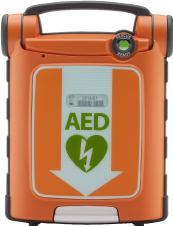Home → Updates → News → Workplace Defibrillators – Do you need one?
Workplace Defibrillators – Do you need one?
Millions of viewers were left stunned and anxious when Christian Eriksen collapsed on the pitch in this year’s Euro 2020 games from a sudden cardiac arrest. Thankfully the immediate action from medical professionals and the use of a defibrillator helped to pull Eriksen back from the brink. In this article, The Compliance People Consultant Dave Almond looks at the merits of workplace defibrillators.
There are approximately 30,000 out-of-hospital cardiac arrests (OHCA) a year within the UK. However, the survival rate is currently low, with only 10% of victims surviving an OHCA. Yet, research has shown that deploying a defibrillator within 3–5 minutes of collapse can produce survival rates as high as 50–70%. Not surprisingly, because of this increase in survival rate, defibrillators, which are officially known as AEDs, are now included within First Aid courses as standard.
But what is an AED?
An AED (automated external defibrillator) is an easy-to-use device which guides the user on exactly how to operate it and what to do, usually with verbal spoken commands. AEDs were designed so the user does not require training.
When a person is unconscious, unresponsive and not breathing, they are likely in cardiac arrest. The heart is no longer pumping blood to the brain and you must act immediately.
In these cases, an AED is used to shock the heart back into a normal rhythm. Crucially, the AED can detect the heart’s electrical impulses or lack of, and it will only instruct the user to deliver a shock if required, ensuring the administering user cannot cause further harm.
The chain of survival
Before we look at AEDs in the workplace, it is essential to see how they fit into what is known as the chain of survival.
When someone suffers a sudden cardiac arrest outside a hospital environment, such as at work, there are four key interrelated steps which, if delivered effectively and in sequence, maximise the chances of survival:
- Early recognition and calling for help (calling for an ambulance and cardiopulmonary resuscitation (CPR)).
- Early CPR from a bystander (in the workplace this is likely to be a first aider).
- Early defibrillation to restart the heart.
- Early advanced life support and standardised post-resuscitation care.
For every minute delay in the use of a defibrillator, the chances of survival for the person fall by 10%.
The Nuffield Trust says the average response time for a Category 1 (‘life-threatening’, which includes cardiac arrest) ambulance response in England was 8 minutes and 7 seconds in March 2020. If you wait for the ambulance to arrive, essential opportunities to maintain life may have been missed. – This is a significant factor in why more employers are introducing AEDs.
AEDs at work – what are the legal requirements?
While there are no legal requirements to provide AEDs at work and no specific regulations which cover the provision or use of AEDs at work, The Health and Safety (First-Aid) Regulations 1981 require employers to provide equipment and facilities which are adequate and appropriate in the circumstances for enabling first-aid to be rendered to their employees if they are injured or become ill at work. This includes the provision of trained first aiders.
An employer can demonstrate that first aid provision is adequate and appropriate through a first aid needs assessment. This will identify the first aid risks and what is needed to manage them (e.g. enough trained first aiders, first aid kits and equipment in suitable locations, etc.).
The assessment should include factors such as:
- The size of the site.
- The number of people on-site.
- The health and safety risks (e.g. hazardous substances, machinery, etc.) on-site.
- Operating hours.
It should also consider the health of people on site. For example, are there staff with heart conditions within the workforce and, if so, how many are there?
Furthermore, a company should consider the geographical site location or any site access issues that may present increased journey times for an ambulance arriving there.
Resuscitation Council UK suggests it would be a flaw to use the close proximity of an ambulance station as justification not to have an AED. With ambulances being deployed to areas where they are needed, indicating ambulances may be a significant distance from the ambulance station and, consequently, the employer.
If there are staff at potential risk of cardiac arrest, then the risk of death from a cardiac arrest is very high; this should therefore require further action from the assessment.
According to the Health and Safety Executive (HSE), where the needs assessment identifies the need for an AED in the workplace, The Provision and Use of Work Equipment Regulations 1998 (commonly known as PUWER) will apply. This requires the employer to provide information and written instructions on how to use the AED.
Useful guidance on how to assess whether your company needs an AED is provided by Resuscitation Council UK.
If you need more help, why not get in touch with us? – Our professional team of consultants offer independent, periodic compliance evaluations for both environment and health & safety.
